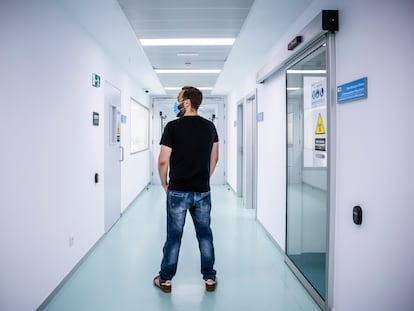Prodrugs: pills your body converts into an illicit drug can evade detection, but we don’t know how big the problem is
These are novel compounds that are not drugs if tested before interacting with people’s metabolism, which complicates their traceability

Drug traffickers have found a way to trick enforcement agencies by using one of the most potent tools our bodies have: our metabolism. Welcome to the world of prodrugs.
Prodrugs are substances that can only cause an effect after being broken down by enzymes in the digestive system or other chemical reactions in the body. While they have legitimate pharmacological uses (between 5% and 7% of approved drugs fall under this category), their use as street drugs is a relatively new phenomenon.
Most illicit drugs work by interacting with specific brain cell receptors, stimulating or blocking the release of chemicals called neurotransmitters. They last for a short time before being transformed into inactive or less active chemicals, which are then eliminated from the body, usually in urine.
For prodrugs, however, a small part of the molecule needs to be removed or substituted before it can act on those receptors. This is done inside the body by natural processes. ALD-52 (1-acetyl-LSD), for example, is a prodrug that is converted by the body into LSD after the removal of two carbon and one oxygen atom.
Although some reports indicate that ALD-52 has been around since the 1960s, it was first officially detected in 2016 by the authorities in France. The U.K. government was quick to list this prodrug as a controlled substance as early as 2014, even though there were no reports of drug seizures or known harms. Since then, many other prodrugs have been identified.
Seizure of LSD prodrugs, such as ALD-52, increased at the height of the Covid pandemic in Italy. Japanese authorities have been dealing with an increasing number of similar LSD prodrug compounds. And in Brazil, the first reports of these LSD prodrug were made in 2022.
The party drug GHB also has a prodrug equivalent. It is called GBL (gamma-butyrolactone).
The U.K. introduced tougher controls for GBL — which is usually sold as a cleaning agent — in 2022. Following strong recommendations from the government’s Advisory Council on Misuse of Drugs, GBL is now classified as a class B drug, alongside cannabis and ketamine.
For stimulants, it is known that some commercially available drugs can be converted in the body into amphetamines and may be abused for their potentially psychoactive effects — which justifies the strict control in their prescription.
Drug traffickers have also developed ways to mask illegal MDMA (ecstasy) by adding a small molecule that can be removed by chemical reactions or in the stomach through contact with gastric acid.
Hard to detect
A major problem with prodrugs is they are difficult to detect. Police forces need reference samples to compare the drug with, or advanced equipment to discover its molecular structure. Since the list of these compounds is not known and minute chemical changes can lead to different patterns to be analyzed, these new drugs are easy to miss. It also explains why many have only appeared in police reports in the past decade.
For biological samples (such as blood, urine or saliva), there is another difficulty. Since the prodrugs must be converted inside the body before they become active, they are, in effect, absent in cases of lethal overdoses, as the substance that causes harm and death is the product of that transformation. So telling apart prodrugs from the more classical components they are converted into is an obstacle. While the overall effects leading to death would be the same, appropriately identifying which drug was originally used can help indicate trends for illegal sales, use and availability.
For GHB prodrugs - namely GBL and 1,4-butanedione - lawmakers have been progressively including them in stricter and more specific legislation. But for LSD prodrugs, in many countries it falls under a gray area. While France, Japan and the U.K. have nominally included ALD-52 and 1p-LSD in their controlled substances laws, in the U.S. and Canada they have to be proved to be an analogue — that is, they possess a similar molecular structure and can cause the same effects — or they are not covered by current law.
In the U.K., new psychoactive substances are defined as either a compound controlled by the Psychoactive Substances Act 2016 or a compound controlled by the Misuse of Drugs Act (post-2008). However, to be included in the Psychoactive Substances Act 2016 there has to be evidence of causing psychoactivity - defined as those compounds that can affect mental functions, such as cognition, mood and emotions.
Psychoactivity can also be determined by laboratory testing. Drugs are incubated with a small number of cells and researchers measure whether they bind to proteins on the surface, which are called receptors. Many prodrugs, however, will not bind to the receptors before they are converted. Where a substance is not listed in the legislation as controlled, and laboratory tests (for molecular similarity or binding to receptors) are required, there’s more room for in-court dissent.
Even if such seizures are infrequent and do not reach the numbers for more commonly used drugs, such as cocaine, cannabis or heroin, their appearance in the illegal market should serve as a warning sign of potentially changing trends in the illicit drug market.
There are potentially unknown effects — in intensity and duration — but also difficulty in prosecuting people who supply these prodrugs. With one new psychoactive substance reaching the illegal market roughly every week in 2021, the sheer diversity of drugs on the market has been indicated as one of the main challenges for toxicologists and forensic chemists.
Julio de Carvalho Ponce is a Lecturer in Forensic Science, University of Winchester.
This article originally appeared in The Conversation.
Sign up for our weekly newsletter to get more English-language news coverage from EL PAÍS USA Edition
Tu suscripción se está usando en otro dispositivo
¿Quieres añadir otro usuario a tu suscripción?
Si continúas leyendo en este dispositivo, no se podrá leer en el otro.
FlechaTu suscripción se está usando en otro dispositivo y solo puedes acceder a EL PAÍS desde un dispositivo a la vez.
Si quieres compartir tu cuenta, cambia tu suscripción a la modalidad Premium, así podrás añadir otro usuario. Cada uno accederá con su propia cuenta de email, lo que os permitirá personalizar vuestra experiencia en EL PAÍS.
¿Tienes una suscripción de empresa? Accede aquí para contratar más cuentas.
En el caso de no saber quién está usando tu cuenta, te recomendamos cambiar tu contraseña aquí.
Si decides continuar compartiendo tu cuenta, este mensaje se mostrará en tu dispositivo y en el de la otra persona que está usando tu cuenta de forma indefinida, afectando a tu experiencia de lectura. Puedes consultar aquí los términos y condiciones de la suscripción digital.
More information
Últimas noticias
From Christmas movies to carols: Trump administration uses the holidays to push its anti-immigrant agenda
Trump’s worldview clashes with a Europe trying to defend itself
The program that guarantees Denver migrants will end up on the ‘Success Wall’
Venezuelan oil, the ultimate prize coveted by the United States
Most viewed
- Christian Louboutin: ‘Young people don’t want to be like their parents. And if their parents wear sneakers, they’re going to look for something else’
- ‘El Limones’ and the growing union disguise of Mexican organized crime
- The low-cost creative revolution: How technology is making art accessible to everyone
- ‘We are dying’: Cuba sinks into a health crisis amid medicine shortages and misdiagnosis
- Cartels in Mexico take a leap forward with narco-drones: ‘It is criminal groups that are leading the innovation race’










































